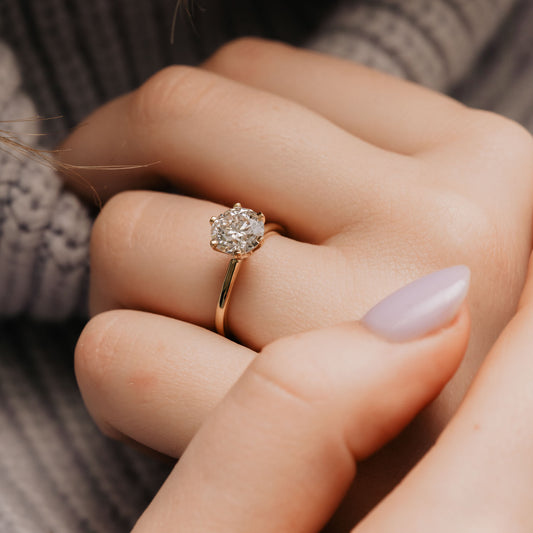The fascination with diamonds has been a piece of human culture for quite a long time, symbolizing eternity, strength, and extravagance. In any case, lately, the rise of lab-grown diamonds has introduced another dynamic into the universe of precious jewels. As we navigate this evolving landscape, a primary question arises: “What are lab diamonds, and how would they compare to normal diamonds #1 question?” This question has become key for the two consumers and gem dealers alike. In this article, we aim to provide a comprehensive understanding of lab diamonds, their creation, their properties, and their offer in the present market.
Table of Contents
What Are Lab Diamonds?
Lab diamonds, otherwise called synthetic or refined diamonds, are diamonds that are created in a controlled laboratory environment as opposed to being mined from the earth. These diamonds have a similar physical, chemical, and optical properties as normal diamonds. The primary difference lies in their origin. While normal diamonds structure more than billions of years under outrageous tension and temperature conditions profound within the world’s mantle, lab diamonds are created using progressed technological cycles that replicate these regular conditions in a significantly more limited time.
The Most common way of Creating Lab Diamonds
There are two main strategies used to make lab diamonds: High-Tension High-Temperature (HPHT) and Chemical Fume Deposition (CVD).
High-Strain High-Temperature (HPHT) Strategy
The HPHT technique mimics the regular formation interaction of diamonds by applying high strain and high temperature to carbon. A little diamond seed is set in a chamber, and carbon is dissolved into it under conditions of outrageous intensity and tension. This cycle permits the carbon to crystallize, forming a diamond. HPHT diamonds are typically utilized for industrial purposes yet can likewise be of pearl quality.
Chemical Fume Deposition (CVD) Strategy
The CVD strategy involves placing a diamond seed in a chamber filled with carbon-rich gas, typically methane. The gas is warmed to high temperatures, causing the carbon particles to break free and deposit onto the seed, layer by layer, growing a diamond over the long haul. CVD diamonds are frequently clearer and of higher quality than those created by the HPHT strategy, making them more suitable for adornments.
Lab Diamonds versus Normal Diamonds: A Detailed Comparison
Composition and Properties
Both lab-grown and regular diamonds are made of crystalline carbon and exhibit identical hardness, refractive index, and warm conductivity. This implies that lab diamonds are all around as tough and brilliant as their regular partners. They are virtually indistinguishable from normal diamonds to the unaided eye and require specialized equipment to recognize differences.
Ethical and Environmental Considerations
One of the main benefits of lab diamonds is their ethical and environmental impact. Unlike regular diamonds, which frequently involve extensive mining operations that can hurt the environment and might be associated with conflict zones (supposed “blood diamonds”), lab diamonds are created in a controlled environment with minimal ecological footprint. This causes them an appealing option for consumers who to prioritize sustainability and ethical sourcing.
Cost and Accessibility
Lab diamonds are for the most part more reasonable than regular diamonds. The price difference can go from 30% to 40% less, depending on the size, quality, and economic situations. This cost-effectiveness is primarily because of the controlled manufacturing process and the shortfall of the mind boggling supply chains required for regular diamonds. Therefore, lab diamonds have become increasingly accessible to a more extensive scope of consumers.
Resale Worth and Perception
One area where lab diamonds differ significantly from regular diamonds is in their resale esteem. Normal diamonds will generally hold their worth over the long haul, frequently increasing in worth. Then again, lab diamonds have a lower resale esteem, which is influenced by their manufactured origin and the perception that they are less rare. Be that as it may, this perception is bit by bit changing as additional consumers recognize the worth and benefits of lab-grown diamonds.
Applications of Lab Diamonds in Gems
Lab diamonds are utilized in a wide variety of gems, from wedding bands to earrings, neckbands, and wristbands. Their versatility and affordability pursue them an incredible decision for those seeking high-quality, beautiful pieces without the premium price tag associated with normal diamonds.
Wedding bands
Lab-grown diamonds have become increasingly famous in wedding bands because of their affordability and ethical sourcing. Couples can pick bigger or higher-quality stones for their budget, without compromising on the brilliance or durability of the diamond. Additionally, lab diamonds offer a wider scope of customization options, allowing for unique and personalized designs.
Earrings and Neckbands
Lab diamonds are additionally widely utilized in earrings and neckbands. Their clarity and brilliance make them ideal for these sorts of gems, where the diamond’s radiance is a key component. Whether set in solitaire earrings or as a component of a more intricate neckband design, lab diamonds provide similar degree of tastefulness and extravagance as normal diamonds.
Arm bands and Other Adornments
From tennis arm bands to pendants and pins, lab diamonds offer vast possibilities for adornments design. Their affordability permits designers to make pieces with bigger stones or more intricate examples, making extravagance gems more accessible to a wider audience.
The Fate of Lab Diamonds
As innovation continues to propel, the quality and availability of lab diamonds are supposed to increase. This could additionally diminish costs and widen their allure. Additionally, as consumers become more eco-conscious and ethically minded, the demand for lab diamonds is likely to develop.
Technological Headways
Innovative work in the field of lab-grown diamonds are continuously pushing the boundaries of what’s possible. Innovations in the CVD and HPHT processes are supposed to upgrade the quality, size, and variety scope of lab diamonds, making them considerably more competitive with normal diamonds.
Changing Consumer Perceptions
Consumer perceptions of lab diamonds are additionally evolving. As awareness of the ethical issues associated with regular diamonds develops, and as the quality of lab diamonds continues to improve, more individuals are choosing lab-grown diamonds for their adornments. This shift in perception is likely to drive further development in the lab diamond market.
Conclusion: Are Lab Diamonds What’s to come?
Lab diamonds address a significant innovation in the diamond industry, offering a compelling alternative to regular diamonds. They combine a similar delight, brilliance, and durability with upgraded ethical and environmental benefits. While they might still be seen by some as less prestigious than normal diamonds, their increasing popularity and acknowledgment propose that they are staying put. For consumers who esteem quality, sustainability, and affordability, lab diamonds are a brilliant choice. As we plan ahead, it appears to be likely that lab diamonds will continue to assume an increasingly important part in the realm of gems, redefining extravagance for another generation.

